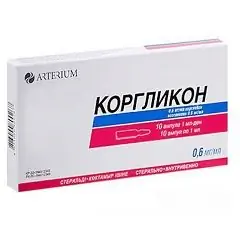- Author Rachel Wainwright [email protected].
- Public 2023-12-15 07:39.
- Last modified 2025-11-02 20:14.
Korglikon
Korglikon: instructions for use and reviews
- 1. Release form and composition
- 2. Pharmacological properties
- 3. Indications for use
- 4. Contraindications
- 5. Method of application and dosage
- 6. Side effects
- 7. Overdose
- 8. Special instructions
- 9. Application during pregnancy and lactation
- 10. Use in childhood
- 11. In case of impaired renal function
- 12. For violations of liver function
- 13. Use in the elderly
- 14. Drug interactions
- 15. Analogs
- 16. Terms and conditions of storage
- 17. Terms of dispensing from pharmacies
- 18. Reviews
- 19. Price in pharmacies
Latin name: Corglycon
ATX code: C01AX
Active ingredient: korglikon (Corglycon)
Producer: Galichpharm, JSC (Ukraine)
Description and photo update: 2019-26-08

Korglikon is a cardiotonic drug, cardiac glycoside.
Release form and composition
Dosage form - solution for intravenous (iv) administration (1 ml in ampoules, in cardboard packs of 10 pcs. Or 10 pcs. In a blister strip, in a cardboard box 1 package and instructions for use of Korglikon).
The active ingredient is korglikon (glycoside of May lily of the valley leaves), in 1 ml - 0.6 mg.
Pharmacological properties
Pharmacodynamics
Korglikon is a purified preparation based on the leaves of May lily of the valley and its varieties. It has a positive inotropic effect, which is due to the direct inhibitory effect of the enzyme Na + / K + -ATPase on the membranes of cardiomyocytes. As a result, the intracellular content of sodium ions increases and, as a result, the content of potassium ions decreases. An increase in the level of sodium ions leads to the activation of sodium-calcium metabolism and an increase in the content of calcium ions, due to which the force of myocardial contraction increases.
An increase in myocardial contractility (contractility) contributes to an increase in the stroke volume of blood, a decrease in the end systolic and end diastolic volumes of the heart. Together with an increase in myocardial tone, these effects lead to a reduction in its size and a decrease in the oxygen demand of the heart muscle.
Korglikon has a negative chronotropic effect. By helping to increase the sensitivity of cardiopulmonary baroreceptors, it inhibits excessive sympathetic activity. Strengthening the activity of the vagus nerve, cardiac glycoside has an antiarrhythmic effect, due to the lengthening of the effective refractory period and a decrease in the speed of impulses through the atrioventricular (AV) node. This effect is enhanced by sympatholytic action and a direct effect on the AV node.
The negative dromotropic effect is manifested by an increase in the refractoriness of the AV node.
In patients with atrial fibrillation, Korglikon slows down ventricular contractions, lengthens diastole, and improves systemic and intracardiac hemodynamics. The positive batmotropic effect is manifested when using the drug in toxic and subtoxic doses.
Korglikon has a direct vasoconstrictor effect, which manifests itself most clearly in the absence of congestive peripheral edema. In this case, the indirect vasodilating effect (in response to an increase in the minute blood volume and a decrease in excessive sympathetic stimulation of vascular tone) usually prevails over the direct vasoconstrictor effect, as a result of which the OPSS (total peripheral vascular resistance) decreases.
After intravenous administration of the drug, the onset of action is noted in 3-5 minutes, the maximum effect develops in 25-30 minutes.
Pharmacokinetics
Korglikon slightly binds to plasma proteins.
Virtually no biotransformation in the liver. It is excreted in the urine unchanged.
Indications for use
- Clinical manifestations of chronic heart failure II-IV functional class, as part of complex therapy;
- Paroxysmal and chronic course of atrial flutter with a tachysystolic form of atrial fibrillation (especially against the background of chronic heart failure).
Contraindications
- The period of pregnancy and breastfeeding;
- Glycosidic intoxication;
- Wolff-Parkinson-White syndrome;
- Atrioventricular (AV) block II degree;
- Intermittent complete blockade;
- Hypersensitivity to korglikon.
With extreme caution, comparing the intended benefits and possible risks, Korglikon should be prescribed to patients: with sick sinus syndrome in the absence of a pacemaker, unstable angina pectoris, atrioventricular blockade of the 1st degree, acute myocardial infarction, an indication of a history of Morgagni-Adams-Stokes attacks mitral stenosis with a rare heart rate, hypertrophic subaortic stenosis, arteriovenous shunt, hypoxia, heart failure with impaired diastolic function (constrictive pericarditis, heart amyloidosis, cardiac tamponade, restrictive cardiomyopathy); at the risk of unstable conduction along the atrioventricular node, extrasystole, cardiac asthma against the background of mitral stenosis (in patients without a tachysystolic form of atrial fibrillation), pulmonary heart,severe dilatation of the cavities of the heart, hypothyroidism, myocarditis, alkalosis, obesity, renal and / or hepatic failure; elderly patients.
In addition, it is recommended to use the drug under the supervision of a physician in patients with impaired plasma electrolyte levels (hypomagnesemia, hypokalemia, hyponatremia, hypercalcemia).
Korglikon, instructions for use: method and dosage
The solution is intended for intravenous slow (within 5-6 minutes) administration.
Korglikon injections are recommended in combination with 10-20 ml of dextrose solution, or glucose (20% or 40%).
The recommended single dosage has age restrictions:
- Adults: 0.5-1 ml each;
- Children: from 2 to 5 years old - 0.2-0.5 ml each, from 6 to 12 years old - 0.5-0.75 ml each.
The use of the drug is indicated 1-2 times a day, with a 2-time appointment, the interval between use of the drug should be observed at 8-10 hours.
The maximum single dose for adults should not exceed 1 ml.
Side effects
The use of Korglikon can cause side effects in patients in case of overdose or hypersensitivity to cardiac glycosides:
- From the side of hematopoietic organs: nosebleeds, thrombocytopenic purpura, thrombocytopenia;
- From the side of the cardiovascular system: AV blockade, arrhythmia;
- From the digestive system: anorexia;
- From the nervous system and sensory organs: headache, confusion, drowsiness, sleep disturbances, delirious psychosis, dizziness, decreased visual acuity;
- Others: allergic reactions.
Overdose
Possible symptoms of Korglikon overdose:
- From the side of the cardiovascular system: atrial fibrillation and flutter, nodal tachycardia, ventricular paroxysmal tachycardia, AV block, ventricular premature beats (often polytopic ventricular premature beats, bigeminy);
- From the senses and the nervous system: decreased visual acuity, flashing of flies in front of the eyes, perception of objects in an enlarged or reduced form, staining visible objects in a yellow-green color, neuritis, manic-depressive syndrome;
- From the digestive tract: abdominal pain, diarrhea, vomiting, anorexia, intestinal necrosis.
When signs of an overdose appear, Korglikon is canceled. The introduction of an antidote (ethylenediaminetetraacetic acid, unitiol) and symptomatic therapy are shown. Class I drugs are used as antiarrhythmic drugs (for example, phenytoin, lidocaine).
In hypokalemia, potassium chloride is administered intravenously for 3 hours (6-8 g per day at the rate of 1-1.5 g per 0.5 L of isotonic dextrose solution and 6-8 U of insulin).
With severe AV blockade and bradycardia, m-anticholinergics are prescribed. The use of beta-adrenostimulants is prohibited because of the danger of potentiating the arrhythmogenic action of cardiac glycoside.
With a complete transverse blockade with attacks of Morgagni-Adams-Stokes, temporary pacing is required.
special instructions
Hypothyroidism, hypokalemia, hypercalcemia, hypomagnesemia, hypernatremia, severe dilatation of cardiac cavities, myocarditis, pulmonary heart disease, obesity, as well as the elderly age of the patient may contribute to an increase in the risk of intoxication.
With severe brady- or normocardia and mitral stenosis, the development of heart failure is due to a decrease in diastolic filling of the left ventricle. Strophanthin, by increasing the contractility of the right ventricular myocardium, further increases the pressure in the pulmonary artery system, which can cause worsening left ventricular failure or pulmonary edema.
The use of the drug is indicated in patients with mitral stenosis with right ventricular failure or atrial fibrillation.
To control the level of digitalization of cardiac glycosides, it is necessary to monitor the level of their concentration in blood plasma.
Influence on the ability to drive vehicles and complex mechanisms
During the period of therapy with Korglikon, patients are advised to refrain from engaging in potentially hazardous activities that require increased concentration of attention and speed of psychomotor reactions, including from driving.
Application during pregnancy and lactation
The drug Korglikon is contraindicated for pregnant and breastfeeding women.
Pediatric use
In pediatrics, according to indications, the drug is recommended to be used from 2 years of age.
With impaired renal function
Korglikon should be used with caution in renal failure.
For violations of liver function
Korglikon should be used with caution in liver failure.
Use in the elderly
It should be borne in mind that elderly patients have an increased risk of developing intoxication with cardiac glycosides.
Drug interactions
The combined use of cardiac glycosides with sodium adenosine triphosphate is not recommended.
With the simultaneous use of Korglikon:
- Ephedrine hydrochloride, norepinephrine hydrotartrate, epinephrine hydrochloride, selective beta-adrenomimetics, as well as xanthine derivatives (including theophylline and caffeine preparations) can contribute to the development of cardiac arrhythmias;
- Corticotropin preparations increase the action of korglikon;
- Aminazine and other phenothiazine derivatives reduce the clinical effect of cardiac glycosides;
- Calcium preparations for parenteral use - increase cardiac arrhythmias and other cardiotoxic effects;
- Glucocorticosteroids against the background of hypokalemia resulting from their prolonged use can cause an increase in the side effects of korglikon;
- Disodium salt of ethylenediaminetetraacetic acid reduces the toxicity and therapeutic effect of cardiac glycosides;
- Anticholinesterase agents increase bradycardia, if necessary, use of corglikon, additionally prescribe the introduction of atropine sulfate;
- Narcotic analgesics, in particular fentanyl, can cause hypotension;
- Potassium supplements reduce the side effects of cardiac glycosides;
- Naproxen does not affect psychological testing results in healthy individuals;
- Paracetamol reduces the excretion of korglikon by the kidneys;
- Diuretics increase the effect of the drug, if necessary, this combination must comply with the optimal dosage of each drug;
- Ergocalciferol, in the case of hypervitaminosis on the background of prolonged use, may enhance the effect of the drug due to the development of hypercalcemia.
Analogs
Korglikon's analogs are: Korglikard, Digoxin, Zelenin Drops, Strofantin K, Adonis-Brom.
Terms and conditions of storage
Store in a dark place at a temperature of 8-15 ° C. Keep out of the reach of children.
Shelf life is 2 years.
Terms of dispensing from pharmacies
Dispensed by prescription.
Reviews about Korglikon
There are practically no reviews about Korglikon on specialized medical sites and forums. This is explained by the fact that the drug is used mainly as part of complex therapy, therefore, it is rather difficult to determine the effectiveness and tolerability of a particular agent. Nevertheless, patients evaluate the therapy, as a rule, positively: atrial fibrillation, heart pain and shortness of breath are stopped, the heart rhythm is restored, and the work of the heart as a whole improves.
Price for Korglikon in pharmacies
The approximate price for Korglikon for a pack of 10 ampoules is 76-100 rubles.

Anna Kozlova Medical journalist About the author
Education: Rostov State Medical University, specialty "General Medicine".
Information about the drug is generalized, provided for informational purposes only and does not replace the official instructions. Self-medication is hazardous to health!






